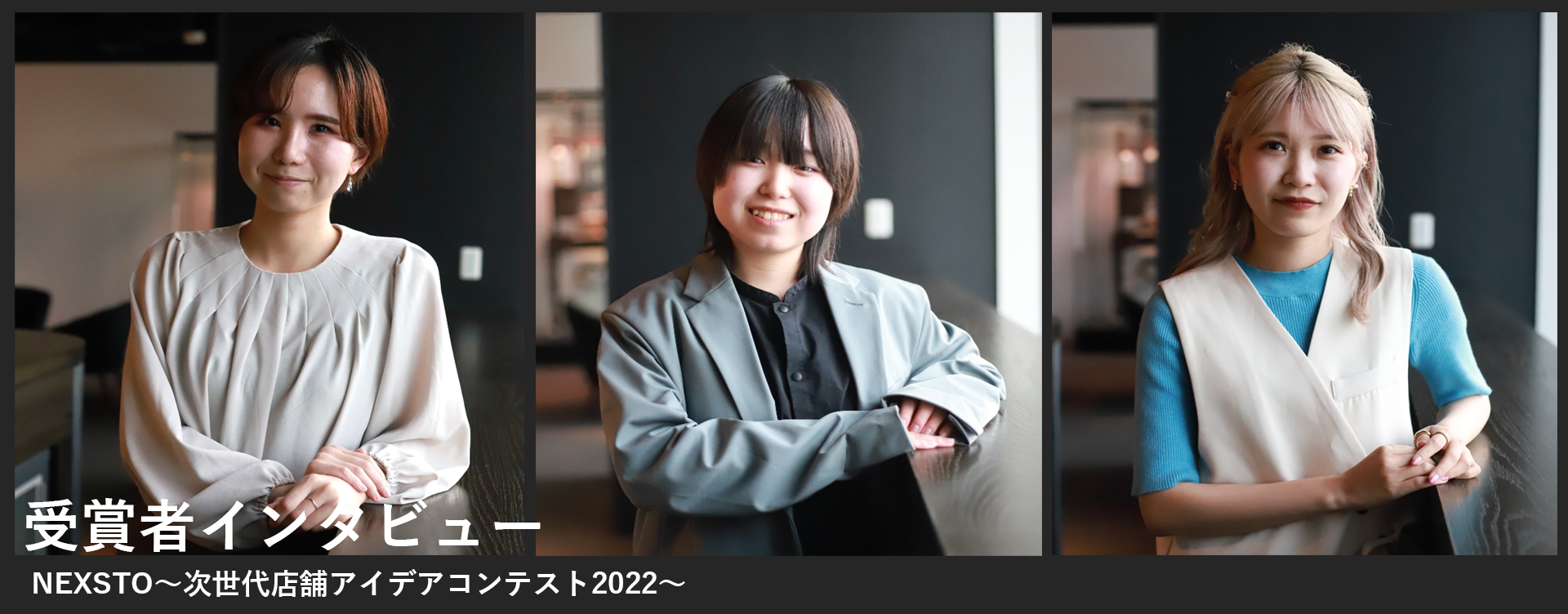
At the second NEXSTO - Next Generation Store Idea Contest 2022, the Grand Prize went to "Matching Everyday!" (Uraguchi Kaho, 3rd year student at Aichi Prefectural University of the Arts), the Excellence Prize went to "Noriori Chari Meguri" (Shigematsu Kirori, 1st year student at Kyoto City University Graduate School), and the Encouragement Prize went to "Transformal" (Satoishi Marumi, 2nd year student at Tokyo University of the Arts Graduate School). In this article, we report on an interview with the three winners conducted by judge Suzuki Akihiro of Tanseisha Cross Media Innovation Headquarters. (Affiliation and interview content are from the time of coverage.)
What made you decide to apply for the "NEXSTO - Next Generation Store Idea Contest 2022"?
Suzuki) Thank you for joining us today. Grand Prize winner Uraguchi-san, Excellence Prize winner Shigematsu-san, and Encouragement Prize winner Satoishi-san. You are all students, right? In 2022, the top three awards were all won by students, beating out the work of many professionals and working adults, which surprised the judges and organizers. In that sense, I'm looking forward to hearing what you have to say today. First of all, please tell us what motivated you to apply for the "NEXSTO - Next Generation Store Idea Contest 2022" (hereinafter referred to as "NEXSTO").
Uraguchi) I was attracted by the theme "excitement". Although I've always been interested in contests, I couldn't apply because I had to prioritize my university assignments. However, I had time to think about stores for my university assignments, and when I started to get interested, I learned about "NEXSTO" on Touryumon (※). The 2021 theme, "New Normal Stores," seemed a bit stiff and I thought it might be a little difficult for me, but the 2022 theme was "excitement," so I thought, "This is it!" and applied.
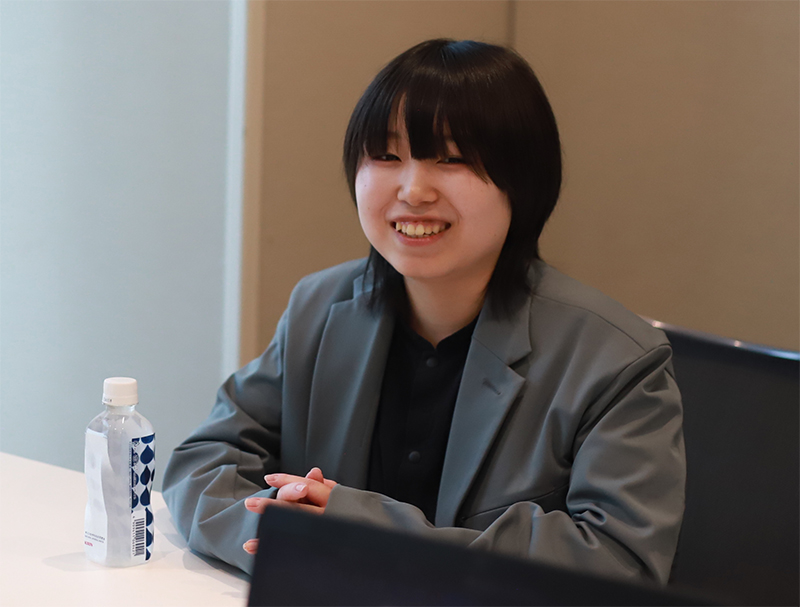
Kaho Uraguchi ※1
Satoishi) I learned about it through an invitation from my university lab. I applied because it was a time when I wanted to show my creative side to the outside world and achieve some kind of results. Up until now, I had worked on a variety of things in the lab, and in a sense, I thought of myself as a generalist. So when it came time to apply, I was unsure which of the many highly specialized contests I should participate in. However, I felt that this "NEXSTO" was a good fit for me, and I saw it as a good opportunity to test my skills, so I applied.
Shigematsu) I also found out about it through Toryumon. I usually participate in contests, but compared to other architecture contests, NEXSTO has fewer conditions and restrictions on submissions, so there's an atmosphere that it's OK to make any kind of proposal. At the time, my university was facing an issue regarding the redevelopment of a commercial facility and was raising various issues, so I thought it would be a good opportunity to utilize the issues and efforts at university and get feedback from various people outside the university, and so I applied.
What do you think about the 2022 theme, "Excitement"?
Suzuki) In the first year, 2021, we solicited ideas that could be implemented under the theme of "Let's think about the new normal store of the next era." As a result, interesting but relatively realistic works by working adults and professionals were awarded. When we discussed the direction of "NEXSTO" again among the judges in preparation for the second event, we realized that everyone was looking forward to fun design and ideas that would excite people. So we decided to take a bold step and make the next theme "excitement." Earlier, Uraguchi-san said that he was attracted to "excitement," but what did you think about the theme?
Uraguchi) I was reminded of the importance of fun. I originally majored in art and started studying design at university, but I was caught up in the idea that design = having to solve problems, which worried me a bit. So this time, I submitted an idea that I found fun, and the judges commented that "it's great that excitement is the goal, not the means," which I found very reassuring. I'm glad I participated.
Suzuki) Thank you. What did you think, Shigematsu-san?
Shigematsu) I also think that excitement is important. I think it should be a given that you should try to create exciting and interesting things. However, in a contest like this, I thought that if the idea was too unlikely to be realized, the judges and organizers might not sympathize with it. "Excitement" is the goal, but how do you design the reality and the consistency of the idea to make it a reality? I think that kind of approach is important.
Suzuki) Just like design engineering, which considers design, technology, and feasibility together, nowadays it is necessary to approach things from both sides. What did you think, Satoishi-san?
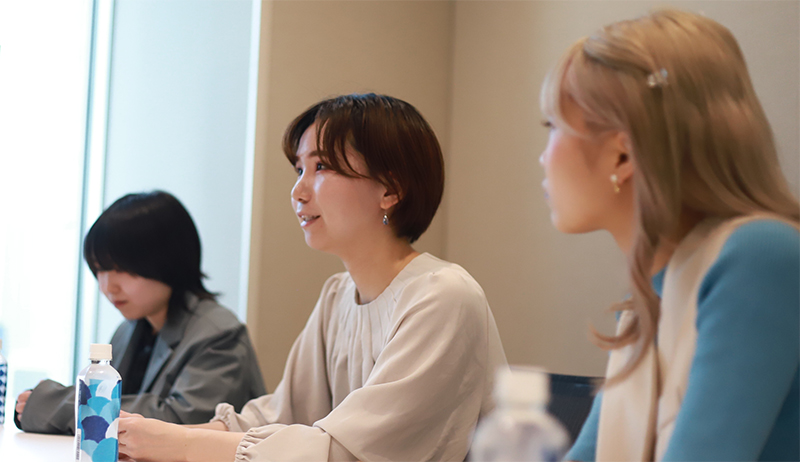
Marumi Satoishi※2
Satoishi) "Exciting" is a vague word, isn't it? (laughs) Designing without a clear goal was a very refreshing experience for me. However, in designing, you need to set goals, and I naturally ended up finding the goal from my own experiences and the stories of the people around me. This time, I listened to a lot of different people say, "I wish there was something like this," and by incorporating my own experiences, I think I was able to propose an idea for a clear service experience.
Suzuki) Thank you. There are many different approaches, and listening to your talk made me realise that each person has to find their own way.
Please tell us an overview of your winning work and the message you wanted to convey.
Suzuki) Could you please tell us again about the outline of your submission and the message you wanted to convey through it?
Shigematsu) "Noriori Chari Meguri" is a multi-story commercial facility that also serves as a bicycle parking lot. It was created in Jiyugaoka, a location that was set up for redevelopment. I feel that Jiyugaoka is a town where you can have a variety of pleasant experiences, but I felt that bicycle parking lots were boring (laughs). I thought it would be nice if users could have more of an experience beyond just parking, and that the facility could make money from the architecture. From there, I thought about how to get on and off bicycles, as well as the commercial aspects.
Suzuki) Shigematsu-san, you're really good at making proposals. When I saw the perspective drawing on the cover, I was first captivated by how cool the architecture was. I could also read the design philosophy from the inside, and it was clear that you had a solid concept in mind. What do you think of Satoishi-san's work?
Satoishi) Simply put, "Transformal" is a rental service for formal wear. For example, on the day when you want to go out wearing your favorite clothes, you also have plans to go to a slightly formal place like today's award winner interview, and you are worried about what to wear, you think that if you have a jacket, you can solve your problem. Since it is inconvenient to carry it around, it would be nice if you could rent it. The target is people who often have the opportunity to go to formal places, so it would be convenient to have it at the station.
Suzuki) This piece really conveys the image of the service. I think service design tends to get a bit complicated, but how did you approach it?
Satoishi) I narrowed it down to a certain extent, and made it with the intention of solving the problem in a simple way. When I thought about "what is exciting?", I thought it was about being able to do what you like, when you like, how you like. I like clothes, so I wondered what it would be like to not be able to wear the clothes I like.
Suzuki) You've really narrowed it down. On the other hand, Shigematsu-san has a different approach.
Shigematsu) In my case, the premise is to create a building. When I thought about an experience that could be transformed into a building, I came up with the idea of a bicycle. On top of that, I simply expressed what I was trying to do and what problem I wanted to solve. I felt that it was important to make it easy for the other person to understand, and in the process of creating it, I felt like I was operating it myself so that I wouldn't deviate from that.
Suzuki) In "NEXSTO," you have to do the assignments yourself. What about Uraguchi's work?
Uraguchi) "Matching Everyday!" is an experiential supermarket, a supermarket that creates encounters. I have the impression that supermarkets are places where many people come and go, but no one exchanges words, and they are lonely. That's when I came up with the term "encounter supermarket." I thought that if two things that seem like opposites were combined, it would be exciting (laughs). From there, when I thought about what kind of situations we normally talk to people in, or are talked to by people, I thought that it would be easier to talk to people with pets or children, and I came up with the idea of a shopping cart that moves freely around the supermarket.
Suzuki) This was a very impactful work. There are shopping cart-type robots with various personalities. Tsui Tsui, Gui Gui, etc. (laughs). I felt that the essence of this was fun and interesting, and above all, the point of view was appreciated by the judges. The coronavirus pandemic is coming to an end, and everyone is a little anxious about what will happen to relationships between people from now on. In supermarkets, there are people, but you just pass each other and don't talk to each other. When we focused on this, we said, "The way you bring insight is very good." In fact, at the final judging, we were originally planning to select two works, the Grand Prize and the Excellence Prize, but the judges strongly supported these three works, so in the end, we decided to create a new Encouragement Prize.
Please tell us about your daily activities and endeavors.
Also, please tell us your understanding of the "next generation."
Suzuki) You mentioned that you often enter contests, Shigematsu, but do your usual creative, design, and architectural endeavors mainly involve university assignments?
Shigematsu) Yes, that’s right. I’m working on my university assignments while also taking part in the contest.
Suzuki) How do you find time to devote to contests?
Shigematsu) I work hard in my free time (laughs). The class schedule is fixed, so it's relatively easy to plan my schedule. I can decide which day of the week I'll use this time for this contest, etc.
Suzuki: That's amazing (laughs). Is there anything you were able to use from your everyday work in the contest?
Shigematsu) When proposing something new, it's important to get the other person to empathize with you, and I think that leads to easier acceptance for the other person. If you talk about what you felt or your own experiences, I think it's easier for the other person to imagine, and it's easier to develop a story in your head. I guess it's evidence for gaining empathy. The idea for this project also started from my usual use of a bicycle.
Suzuki) So your focus is on everyday, casual actions. How do you see the next generation?
Shigematsu) Simply put, it's something new. However, it doesn't have to be something completely new, but it can be something that exists now, or something that has new elements or experiences added to it. When new and old parts are combined, the next generation can be perceived as something that looks new overall.
Suzuki) I think that in today's world, newness is often born through convergence. In that case, something that resonates with people will become an experience that makes them feel new. What about you, Satoishi?
Satoishi) After publishing this work, my way of thinking has changed. I usually study technology, and there are many cases where we rely on technology or development costs, i.e. money, to solve problems, but I began to think that it would be better if we could solve problems with simpler, more human actions rather than relying on those things. I would like to expand on the very ordinary things that exist in our daily lives.
Suzuki) What faculty are you in, Satoishi-san?
Satoishi) I'm in the design department. The lab I belong to advocates speculative design, and we try to solve problems creatively.
Suzuki) So you're always researching ways to solve problems. What about the next generation?
Satoishi) In a word, I think the next generation is full of useless things and useless elements. AI is evolving at an incredible speed now, but if we pursue useless things and things that don't make money, I think the next generation will naturally emerge from that. At that point, you don't know what will ultimately connect or be useful. I think that's a creative and graceful act that is truly human.
Suzuki) I agree. Even in the workplace, if you don't just focus on "newness" but organize and think about the things around you, you can sometimes make unexpected discoveries.
What about you, Uraguchi-san?
Uraguchi) I'm currently studying design because I want to solve problems with design. As I said at the beginning, before I applied to this contest, I felt like I was caught up in a lot of things and wasn't able to create anything that really felt right. But then I encountered "wakuwaku," and I was able to let go of all my restrictions and try to create something that was completely different. So rather than this piece being born from my everyday experiences, I feel like this piece gave birth to my next experience.
Suzuki) That's interesting. What about the next generation?
Uraguchi) The important thing is to be able to imagine the future. I think it's important to convince everyone that "this future seems fun." In this day and age when anything seems possible, I want to convey bold ideas to students, and I hope that they will be able to use them in the creation of things when they enter society.
Suzuki) I think that's something that's necessary when working on creativity. After hearing your story, I feel that way again.
Participated in the "NEXSTO - Next Generation Store Idea Contest 2022" Please leave your comments and messages.
Suzuki) Finally, please tell us your impressions of participating in NEXSTO and your message to those applying in 2023.
Shigematsu) The wide range of submissions was good for me when I applied. I was able to use my imagination freely. My message to applicants is that although many people who want to create something new apply to these types of contests, some people give up because they can't solve the problem. It may take time, but I think it's important to face an idea that you want to try and create a story that makes people think it would be fun if it actually happened.
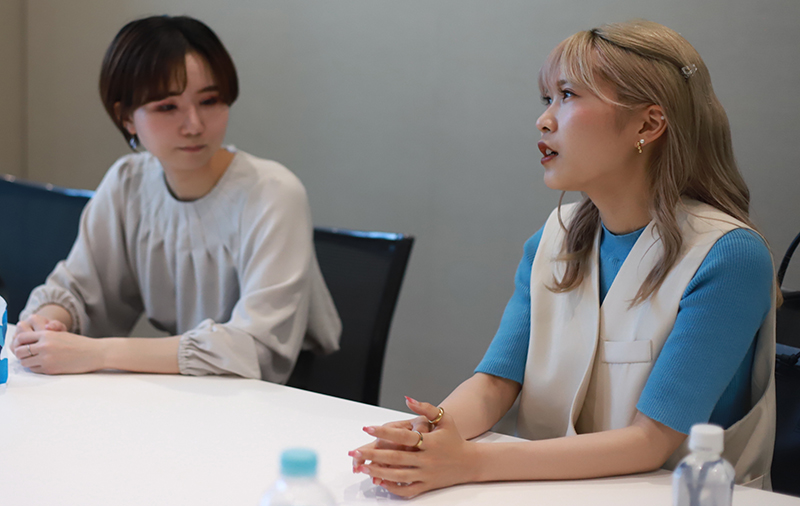
Kiri Shigematsu※3
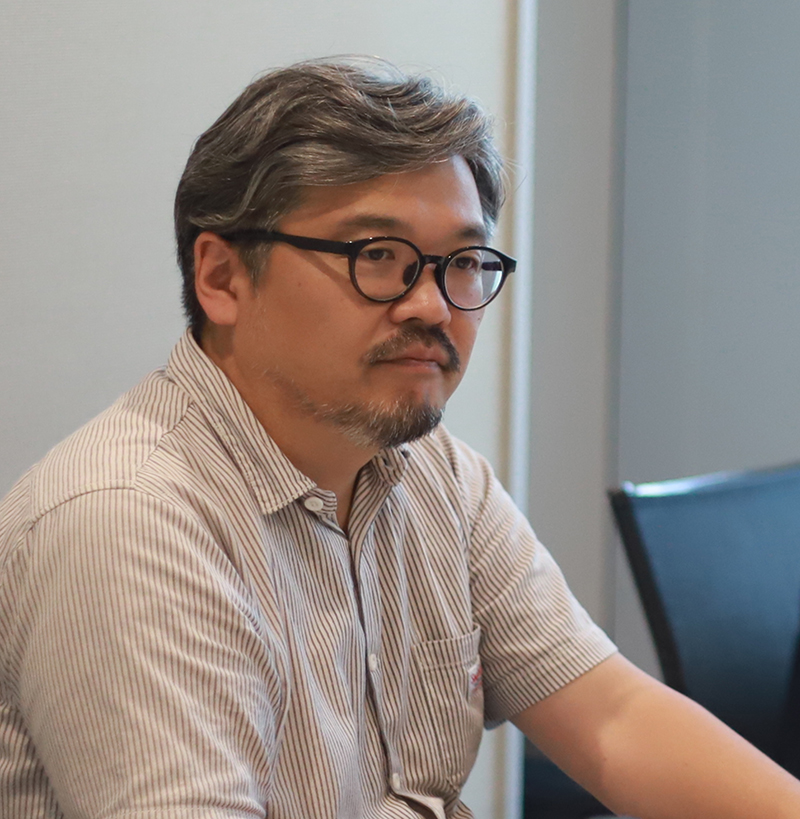
Akihiro Suzuki
Suzuki) For example, I want to treasure the first ideas that come to mind, and they are surely the result of some kind of trigger. In the process of shaping something through trial and error, there are things that you may not have noticed yourself, but as I mentioned earlier, once you expand and organize it, you may realize later that this is what it was all about. Also, when something works, it often comes together without any effort. So, Satoishi-san, what do you think?
Satoishi) This contest got me thinking about what "excitement" means. Because it is such a universal theme, I don't usually think about it that much. I'm glad I participated in the contest, as it gave me the opportunity to think about it. When 2023 becomes a broad theme, I can think about it, either alone or as a team, and I think that will be a great opportunity.
Suzuki) We are thinking of making the theme for 2023 "comfort". I think what makes something comfortable for each person is different. How will the applicants perceive it? I would like to see where they will focus their attention in terms of insight, and I am looking forward to seeing their approach to it. I hope we will be able to get a glimpse of the things that the award winners have talked about today.
Finally, what do you think, Uraguchi-san?
Uraguchi) During the judging process, I felt like I was not just being evaluated, but that they were communicating with me. At first, I thought it was more of a spatial design contest, and I was worried that my work was a bit out of place, but when I told them about Insight during the second round of judging, they showed a lot of interest. As a result, I was able to approach the final round with confidence. I thought it was a great opportunity to be able to take on other people's perspectives.
Suzuki) In 2022, many young people like you participated, and we received many powerful works. Of course, working adults and professionals also participated. However, I think that the students were able to monopolize the awards because there were many works that strongly expressed the ideas of the next generation and the thoughts of young people who will create the future, in response to the theme of "excitement." Thank you very much to all the award winners today.
*1
Kaho Uraguchi
Aichi Prefectural University of Fine Arts and Music, 3rd year
Faculty of Fine Arts, Department of Design and Crafts, Design Major
*2
Shigematsu Kirari
Kyoto City University Graduate School
Graduate School of Science and Engineering, Department of Architecture and Urban Planning, Architecture Field
Takaharu Tezuka Laboratory Master's course 1st year
*3
Marumi Satoishi
Tokyo University of the Arts Graduate School
Graduate School of Fine Arts, Design major, Master's 2nd year